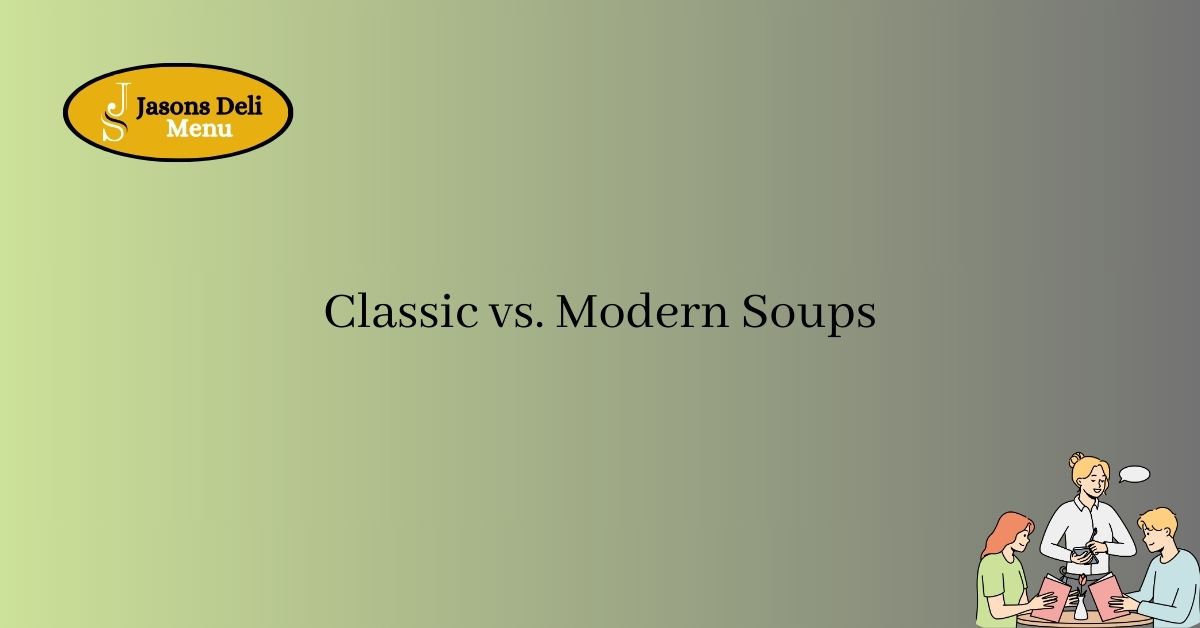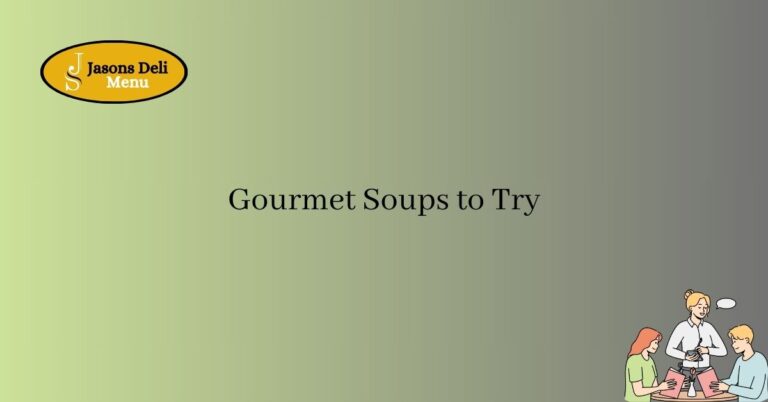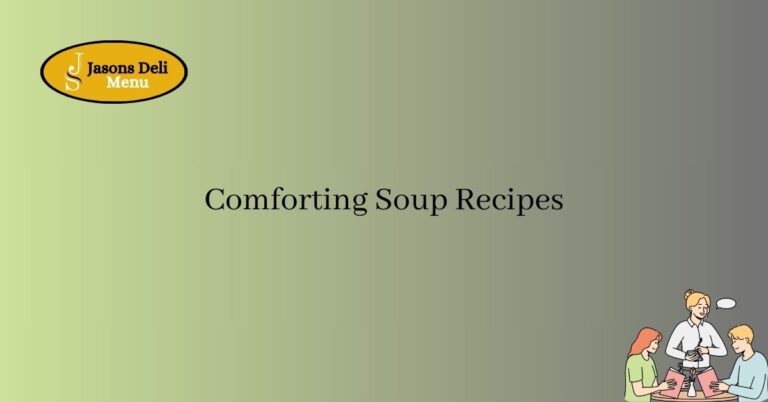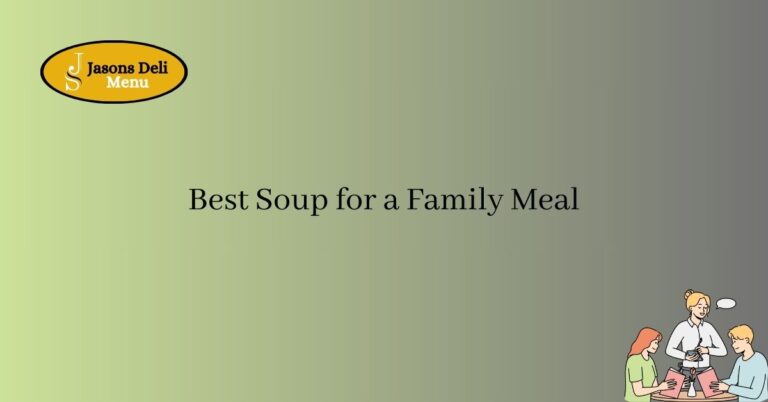Classic vs. Modern Soups
Classic vs. Modern Soups presents a delightful culinary journey that highlights the evolution of this beloved dish. Traditionally, soups have been a staple in various cultures, often made from simple ingredients like vegetables, meats, and grains. These classic recipes, passed down through generations, provide comfort and nourishment. They emphasize the importance of slow cooking and the rich flavors that develop over time, often showcasing the seasonal produce available in local markets. As people sought heartier meals during colder months, these timeless recipes became synonymous with warmth and satisfaction, making them a cherished part of family gatherings and celebrations.
In contrast, modern soups have embraced innovation and creativity, reflecting contemporary tastes and dietary preferences. With the rise of global cuisine, chefs are now experimenting with bold flavors, unique combinations, and alternative ingredients. Modern interpretations often incorporate elements like exotic spices, superfoods, and even plant-based ingredients, appealing to health-conscious consumers. This evolution within the realm of soups is not only a testament to culinary creativity but also a response to changing lifestyles and dietary needs. At establishments like Jason’s Deli, the menu often reflects this blend of classic comfort and modern flair, offering selections that cater to a diverse clientele while still honoring traditional soup-making techniques.
The Evolution of Soup: Classic vs. Modern Interpretations
Soup has been a staple in human diets for thousands of years, with its roots tracing back to ancient civilizations. Evidence suggests that the earliest soups were made by boiling meat in water, a technique utilized by cultures such as the Romans and the Chinese. Throughout history, soup has served various purposes, from a nourishing meal for the less fortunate to a luxurious dish for banquets. As culinary techniques evolved, so did soup recipes, incorporating local ingredients and flavors that reflected the culture of the time. Traditional recipes have been passed down through generations, often becoming family heirlooms. Today, soups remain a global comfort food, uniting diverse cultures through shared ingredients and flavors.
Essential Ingredients in Classic Soup Recipes
Classic soups typically rely on a few essential ingredients that form the foundation of their flavor. Common elements include stocks or broths, vegetables, and proteins. The choice of stock—whether chicken, beef, or vegetable—greatly influences the soup’s overall taste. Fresh, seasonal produce plays a pivotal role, allowing flavors to shine. Ingredients like carrots, onions, and celery form the aromatic base known as mirepoix, which is essential in many classic soups. Additionally, slow cooking techniques are often employed to develop depth of flavor, as the ingredients meld together over time, creating a rich and satisfying bowl of soup.
Seasonal Produce and its Importance
Incorporating seasonal produce is key to crafting flavorful classic soups. Using ingredients that are in season ensures peak freshness and taste, ultimately enhancing the dish. For example, winter soups often feature root vegetables like potatoes and squash, while spring soups may highlight peas and asparagus. This seasonal approach not only supports local agriculture but also promotes sustainability. Moreover, utilizing seasonal produce allows cooks to experiment with various flavors and textures, making each soup unique to the time of year it is prepared.
Slow Cooking Techniques for Depth of Flavor
Classic soups often benefit from slow cooking techniques that allow flavors to develop fully. By simmering ingredients gently over a longer period, cooks can extract the essence of each component, resulting in a harmonious blend of tastes. Techniques such as braising or stewing can intensify flavors and create a comforting, hearty dish. Using a slow cooker or stovetop pot, chefs can layer ingredients thoughtfully, adding them at different intervals to ensure each element retains its integrity. This method not only enhances flavor but also promotes a wholesome, nourishing meal.
Innovations in Modern Soup Preparations
The landscape of soup has transformed dramatically with the advent of modern culinary techniques and trends. Today’s chefs are not bound by traditional recipes; instead, they innovate by incorporating global flavors and unique spices into their soups. This evolution has given rise to a variety of modern options, such as Thai coconut soup or Moroccan harira, which blend traditional elements with contemporary flavors. Innovations in preparation methods, such as blending ingredients for creamy textures or employing sous-vide cooking, have also expanded the possibilities for creating delightful soups that cater to diverse palates.
Incorporating Global Flavors and Exotic Spices
Modern soups often feature an array of global flavors and exotic spices that elevate the dining experience. Ingredients such as lemongrass, ginger, and saffron can transform a simple broth into a vibrant, aromatic dish. Chefs are increasingly experimenting with international cuisines, drawing inspiration from Southeast Asian, Middle Eastern, and Latin American culinary traditions. This fusion approach allows for endless creativity, offering diners a taste of the world in a single bowl. Such modern options not only reflect personal tastes but also cater to a diverse audience seeking new and exciting flavor profiles.
Health-Conscious Ingredients in Today’s Soups
As health awareness grows, modern soup recipes are increasingly focused on health-conscious ingredients. The rise of plant-based diets has led to the inclusion of legumes, whole grains, and nutrient-dense vegetables in soups. Many contemporary recipes prioritize low-sodium broths and fresh herbs to enhance flavor without compromising health. Additionally, superfoods like kale and quinoa have found their way into many soup recipes, providing added nutritional benefits. This shift towards healthier options aligns with broader dietary trends, making soup a versatile choice for those seeking both comfort and nutrition.
Comparison of Flavor Profiles: Classic vs. Modern
When comparing classic and modern soups, the flavor profiles can differ significantly. Classic soups tend to emphasize deep, rich flavors achieved through slow cooking and simple ingredients. They often evoke nostalgia and warmth, making them comforting staples. In contrast, modern soups may feature bold, eclectic flavors that appeal to adventurous eaters. The use of spices and global influences creates a dynamic range of tastes, from spicy to sweet, allowing for a more complex flavor experience. This evolution reflects changing consumer preferences and the culinary landscape’s responsiveness to new trends.
Impact of Dietary Trends on Soup Choices
Dietary trends play a significant role in shaping soup choices today. The growing demand for plant-based meals has led to an increase in vegetarian and vegan soups that are both satisfying and nutritious. Additionally, the popularity of gluten-free and low-carb diets has prompted chefs to create soups that cater to these preferences, incorporating alternative grains and vegetables. With a focus on health and wellness, many consumers are gravitating towards soups that feature superfoods and organic ingredients. These trends are not only changing the way soup is prepared but also influencing the types of ingredients that are favored in contemporary recipes.
Popularity of Plant-Based and Superfoods
The popularity of plant-based diets has significantly impacted soup recipes, leading to the incorporation of a wide variety of vegetables, legumes, and grains. Ingredients such as lentils, chickpeas, and quinoa are now common in many soups, providing protein and fiber while appealing to health-conscious diners. Superfoods like kale, spinach, and turmeric are also being embraced for their nutritional benefits, enhancing both the flavor and health value of soups. This trend reflects a broader movement towards wholesome eating, making soup not just a comforting dish but also a nourishing option that aligns with modern dietary preferences.
Balancing Tradition with Contemporary Preferences
Finding the balance between traditional soup recipes and contemporary preferences is an art form. Many chefs are revisiting classic soups and infusing them with modern twists, creating hybrid dishes that respect culinary heritage while appealing to today’s palates. For example, a classic tomato basil soup may be elevated with the addition of roasted garlic or a drizzle of balsamic glaze, enhancing its flavor while maintaining its comforting essence. This fusion of old and new allows for creativity in the kitchen, ensuring that soups remain relevant and cherished across generations. By embracing both classic and modern options, soup continues to evolve while honoring its rich history.
Frequently Asked Questions
This section aims to provide clarity on common inquiries related to classic and modern soups, particularly as they pertain to Jason’s Deli Menu. Here, readers can find concise answers to enhance their understanding of soup offerings and the culinary evolution that defines them.
What defines classic soups?
Classic soups are typically characterized by traditional recipes that emphasize slow cooking with simple, wholesome ingredients like seasonal vegetables, meats, and grains. Passed down through generations, these soups focus on rich flavors and comforting textures, often associated with home-cooked meals and cultural heritage.
How do modern soups differ from classic ones?
Modern soups embrace innovation, incorporating bold flavors, unique combinations, and alternative ingredients that reflect contemporary dietary preferences. Chefs often experiment with exotic spices and superfoods, appealing to health-conscious consumers while maintaining a creative twist on traditional soup-making techniques.
What are some popular classic soups?
Popular classic soups include chicken noodle, minestrone, and tomato bisque. These soups are beloved for their comforting qualities and simplicity, often made with fresh, local ingredients that enhance their flavor profiles. They evoke nostalgia and warmth, making them a staple during family gatherings and colder months.
Are modern soups healthier than classic soups?
Modern soups tend to incorporate healthier ingredients, such as plant-based options and superfoods, catering to contemporary dietary trends. They often focus on bold flavors and nutritional value, making them appealing to a wide audience, including those seeking balanced meals without sacrificing taste.
How does Jason’s Deli reflect classic and modern soup trends?
Jason’s Deli offers a diverse menu that showcases a blend of classic comfort foods and modern innovations. By honoring traditional soup-making techniques while also introducing contemporary flavors and ingredients, the menu caters to a varied clientele, ensuring that both classic and modern soup enthusiasts are satisfied.






